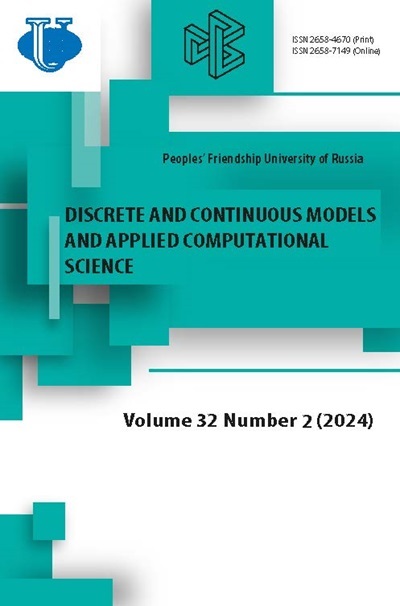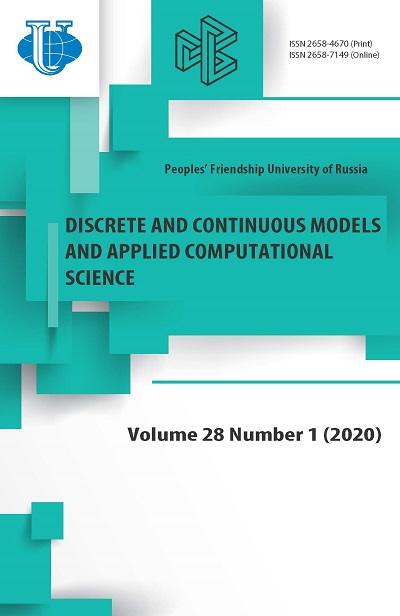Вычисление нормальных мод закрытых волноводов
- Авторы: Малых М.Д.1, Диваков Д.В.1, Егоров А.А.2, Кузив Я.Ю.1
-
Учреждения:
- Российский университет дружбы народов
- Институт общей физики имени А. М. Прохорова РАН
- Выпуск: Том 28, № 1 (2020)
- Страницы: 62-76
- Раздел: Математическое моделирование
- URL: https://journals.rudn.ru/miph/article/view/23697
- DOI: https://doi.org/10.22363/2658-4670-2020-28-1-62-76
Цитировать
Полный текст
Аннотация
Целью работы является разработка и создание численных методов решения некоторых задач теории волноводов, а также их реализация в виде комплексов программ, ориентированных на широкий круг практических проблем от классических вопросов передачи СВЧ излучения до проектирования оптических волноводов и датчиков. При этом мы стремимся к простоте реализации разрабатываемых методов в системах компьютерной алгебры (Maple, Sage) или в программном обеспечении, ориентированном на метод конечных элементов (FreeFem++). В работе использовано представление электромагнитных полей в волноводе при помощи четырёх потенциалов. Эти потенциалы не уменьшают число искомых функций, но даже в том случае, когда диэлектрическая и магнитная проницаемости описываются разрывными функциями, они оказываются достаточно гладкими функциями. Сделана простейшая проверка работоспособности программ путём вычисления нормальных мод полого волновода. Показано, что относительная ошибка в вычислении первых 10 нормальных мод не превышает 4%. Эти результаты свидетельствуют о работоспособности предложенного в настоящей статье метода.
Об авторах
Михаил Дмитриевич Малых
Российский университет дружбы народов
Автор, ответственный за переписку.
Email: malykh-md@rudn.ru
доктор физико-математических наук, доцент кафедры прикладной информатики и теории вероятностей
ул. Миклухо-Маклая, д. 6, Москва, 117198, РоссияДмитрий Валентинович Диваков
Российский университет дружбы народов
Email: divakov-dv@rudn.ru
кандидат физико-математических наук, ассистент кафедры прикладной информатики и теории вероятностей
ул. Миклухо-Маклая, д. 6, Москва, 117198, РоссияАлександр Алексеевич Егоров
Институт общей физики имени А. М. Прохорова РАН
Email: yegorov@kapella.gpi.ru
доктор физико-математических наук, главный научный сотрудник отдела колебаний
ул. Вавилова, д. 38, Москва, 119991, РоссияЯрослав Юрьевич Кузив
Российский университет дружбы народов
Email: yaroslav.kuziw@yandex.ru
аспирант кафедры прикладной информатики и теории вероятностей
ул. Миклухо-Маклая, д. 6, Москва, 117198, РоссияСписок литературы
- A. Taflove and S. C. Hagness, Computational electrodynamics: the finite difference time domain method, 2nd ed. London: Artech House, 2000.
- A. A. Egorov and A. V. Stavtsev, “Specifics of the development of algorithms and programs for computing the main characteristics of integrated-optical waveguides [Osobennosti razrabotki algoritmov i programm dlya rascheta osnovnykh kharakteristik neregulyarnykh integral’no-opticheskikh volnovodov],” Vychisl. Metody Programm., vol. 11, no. 2, pp. 184-192, 2010, in Russian.
- A. A. Egorov, “Theoretical, experimental and numerical methods for investigating the characteristics of laser radiation scattered in the integrated-optical waveguide with three-dimensional irregularities,” Quantum Electronics, vol. 41, no. 7, pp. 644-649, 2011. DOI: 10.1070/ QE2011v041n07ABEH014560.
- A. G. Sveshnikov, “On the proof of a method of calculation for irregular waveguides,” USSR Computational Mathematics and Mathematical Physics, vol. 3, no. 1, pp. 219-232, 1963. doi: 10.1016/0041-5553(63) 90132-0.
- A. G. Sveshnikov, “A substantiation of a method for computing the propagation of electromagnetic oscillations in irregular waveguides,” USSR Computational Mathematics and Mathematical Physics, vol. 3, no. 2, pp. 413-429, 1963. doi: 10.1016/0041-5553(63)90027-2.
- A. N. Bogolyubov and T. V. Edakina, “Application of variationaldifference methods to dielectric waveguide calculations,” Moscow University Physics Bulletin, vol. 46, no. 2, p. 7, 1991.
- D. V. Divakov, M. D. Malykh, A. L. Sevastianov, and L. A. Sevastianov, “Simulation of Polarized Light Propagation in the Thin-Film Waveguide Lens [Modelirovaniye rasprostraneniya polyarizovannogo sveta v tonkoplonochnoy volnovodnoy linze],” RUDN Journal of Mathematics, Information Sciences and Physics, vol. 25, no. 1, pp. 56-68, 2017, in Russian. doi: 10.22363/2312-9735-2017-25-1-56-68.
- A. N. Bogolyubov, A. A. Petukhov, and N. E. Shapkina, “Mathematical modeling of waveguides with fractal insets,” Moscow University Physics Bulletin, vol. 66, no. 2, pp. 122-125, 2011. DOI: 10. 3103 / S0027134911020044.
- A. Extance, “Redefining the limits of optical fibre,” Optical connections, vol. 9, no. Q2, pp. 12-13, 2017.
- V. C. Coffey, “Novel fibers use space to extend capacity limits,” Photonics Spectra, vol. 4, no. 7, 2013.
- D. V. Divakov, K. P. Lovetskiy, M. D. Malykh, and A. A. Tiutiunnik, “The Application of Helmholtz Decomposition Method to Investigation of Multicore Fibers and Their Application in Next-Generation Communications Systems,” in Communications in Computer and Information Science, V. Vishnevskiy and D. Kozyrev, Eds., DCCN 2018: Distributed Computer and Communication Networks, vol. 919, Cham: Springer, 2018, pp. 469-480. doi: 10.1007/978-3-319-99447-5_40.
- P. Deuflhard, F. Schmidt, T. Friese, and L. Zschiedrich, “Adaptive Multigrid Methods for the Vectorial Maxwell Eigenvalue Problem for Optical Waveguide Design,” in Mathematics - Key Technology for the Future, W. Jäger and H. J. Krebs, Eds., Berlin-Heidelberg: Springer, 2011, pp. 279-292. doi: 10.1007/978-3-642-55753-8_23.
- F. Schmidt, S. Burger, J. Pomplun, and L. Zschiedrich, “Advanced FEM analysis of optical waveguides: algorithms and applications,” Proc. SPIE, vol. 6896, 2008. doi: 10.1117/12.765720.
- E. Lezar and D. B. Davidson, “Electromagnetic waveguide analysis,” in Automated solution of differential equations by the finite element method, The FEniCS Project, 2011, pp. 629-643. doi: 10.1007/978-3-64223099-8_34.
- A. N. Bogolyubov, A. L. Delitsyn, and A. G. Sveshnikov, “On the problem of excitation of a waveguide filled with an inhomogeneous medium,” Computational Mathematics and Mathematical Physics, vol. 39, no. 11, pp. 1794-1813, 1999.
- A. L. Delitsyn, “An approach to the completeness of normal waves in a waveguide with magnetodielectric filling,” Differential Equations, vol. 36, no. 5, pp. 695-700, 2000. doi: 10.1007/BF02754228.
- A. L. Delitsyn, “On the completeness of the system of eigenvectors of electromagnetic waveguides,” Computational Mathematics and Mathematical Physics, vol. 51, no. 10, pp. 1771-1776, 2011. DOI: 10.1134/ S0965542511100058.
- N. A. Novoselova, S. B. Raevskiy, and A. A. Titarenko, “Calculation of characteristics of symmetric modes propagating in a circular waveguide with radially-heterogeneous dielectric filling [Raschet kharakteristik rasprostraneniya simmetrichnykh voln kruglogo volnovoda s radial’noneodnorodnym dielektricheskim zapolneniyem],” Bulletin of Novgorod State Technical University n.a. R.E. Alekseev, no. 2(81), pp. 30-38, 2010, in Russian.
- A. L. Delitsyn, “On the problem of scattering in a nonuniform waveguide,” Computational Mathematics and Mathematical Physics, vol. 40, no. 4, pp. 577-581, 2000.
- A. L. Delitsyn, “A Diffraction Problem in a Waveguide,” Differential Equations, vol. 41, no. 3, pp. 393-400, 2005. doi: 10.1007/s10625-005- 0171-9.
- Y. G. Smirnov, “Completeness of the system of eigenand associated waves of a partially filled waveguide with an irregular boundary,” Soviet Mathematics. Doklady, vol. 297, no. 4, pp. 829-832, 1987.
- Y. G. Smirnov, “The method of operator pencils in boundary value problems of conjugation for a system of elliptic equations,” Differential Equations, vol. 27, no. 1, pp. 112-118, 1991.
- A. N. Bogolyubov, A. L. Delitsyn, and A. G. Sveshnikov, “On the completeness of the set of eigenand associated functions of a waveguide,” Computational Mathematics and Mathematical Physics, vol. 38, no. 11, pp. 1815-1823, 1999.
- A. N. Bogolyubov, A. L. Delitsyn, M. D. Malykh, and A. G. Sveshnikov, “The basis property of root vectors for the radio waveguide,” Moscow University Physics Bulletin, vol. 55, no. 6, pp. 22-26, 2000.
- A. N. Bogolyubov, A. L. Delitsyn, and M. D. Malykh, “On the root vectors of a cylindrical waveguide,” Computational Mathematics and Mathematical Physics, vol. 41, no. 1, pp. 121-124, 2001.
- K. S. Chiang, “Review of numerical and approximate methods for the modal analysis of general optical dielectric waveguides,” Optical and Quantum Electronics, vol. 26, Sll3-S134, 1994. DOI: 10. 1007 / BF00384667.
- A. L. Delitsyn and S. I. Kruglov, “Mixed finite elements for cylindrial waveguides real and complex mode analysis,” Moscow University Physics Bulletin, no. 6, pp. 53-58, 2011. doi: 10.3103/S0027134911060063.
- C. Müller, Grundprobleme der mathematischen Theorie elektromagnetischer Schwingungen, German. Berlin, Heidelberg: Springer, 1957.
- J. Jin, The Finite Element Method in Electromagnetics, 2nd ed. New York: John Wiley & Sons Inc., 2002.
- M. D. Malykh, N. E. Nikolaev, L. A. Sevastianov, and A. A. Tiutiunnik, “On the representation of electromagnetic fields in closed waveguides using four scalar potentials,” Journal of Electromagnetic Waves and Applications, vol. 32, no. 7, pp. 886-898, 2018. doi: 10.1080/09205071. 2017.1409137.
- M. D. Malykh and L. A. Sevast’yanov, “On the Representation of Electromagnetic Fields in Discontinuously Filled Closed Waveguides by Means of Continuous Potentials,” Computational Mathematics and Mathematical Physics, vol. 59, no. 2, pp. 330-342, 2019. DOI: 10.1134/ S0965542519020118.
- M. D. Malykh, L. A. Sevastianov, and A. A. Tiutiunnik, “Calculation of normal modes of the closed waveguides in general vector case,” Proceedings of SPIE - The International Society for Optical Engineering, vol. 10717, 107170Z, 2018. doi: 10.1117/12.2315158.
- A. A. Tyutyunnik, “On the Calculation of Electromagnetic Fields in Closed Waveguides with Inhomogeneous Filling,” RUDN Journal of Mathematics, Information Sciences and Physics, vol. 26, no. 2, pp. 129- 139, 2018, in Russian. doi: 10.22363/2312-9735-2018-26-2-129-139.
- G. Hellwig, Partial Differential Equations. An Introduction. Leipzig: Teubner, 1960.
















